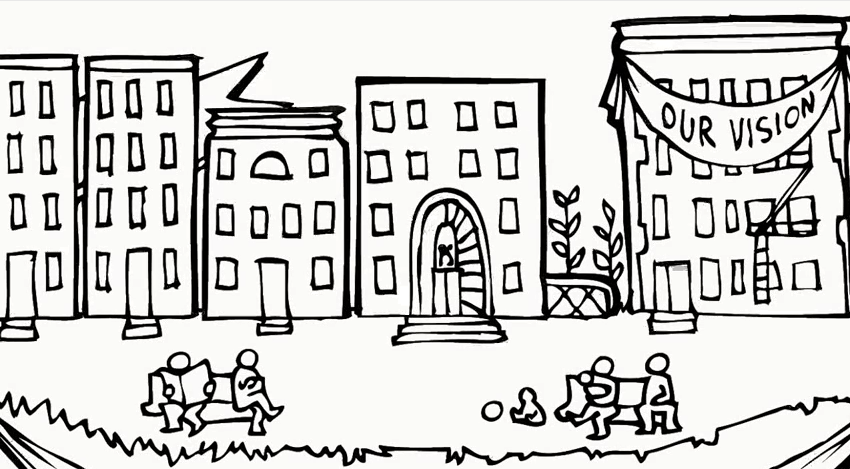New York City, July 29, 2015

★ “What am I smelling?” the three-year-old said, out in the noisome morning. “I think I’m smelling W — ‘s dirty feet.” The heat was not so bad, for a minute, on the walk toward the river, but on the way back, facing into a sun a few minutes higher, it was. Lane markings and crosswalks and crushed garbage had been added to the blank fresh new blacktop of Amsterdam Avenue. The day would stay as it had been: brutal but weak-willed. In the afternoon, a shady avenue seemed bearable; rounding the corner onto a cross street in full sun and grill-cart smoke was like stepping off an elevator into Hell. The evening was not too hot for trailing a scooter back and forth, but it was too humid for it. A stranger on the plaza held forth on how miserable his own day had been, bicycling around and stopping off to change.
The Ungentrifiers
by Brendan O’Connor

In 1959, the Cooper Square Committee formed to organize against Robert Moses’ plan to tear down the twelve blocks in the East Village, which was at the time a low-income neighborhood, from Delancey Street to 9th Street, from Second Avenue to the Bowery, thereby displacing some twenty-four hundred tenants, four hundred and fifty furnished room occupants, four thousand homeless people, and five hundred businesses. The buildings would have been replaced with nearly three thousand units of cooperative housing, which have been affordable to just seven percent of the people living in the neighborhood at the time. In 1961, activists like Walter Thabit and Frances Goldin formulated the Alternate Plan for Cooper Square. “A renewal effort has to be conceived as a process of building on the inherent social and economic values of a local community. Neglecting these values through programs of massive clearance and redevelopment can disrupt an entire community,” the plan begins. “The physical improvements which will attract a higher income group must — first of all — benefit those affected by the program, not cause them to suffer from it.”
Thirty-five years later, after many legal and legislative battles, the Cooper Square Committee incorporated as a community land trust and mutual housing association. Basically, what this does is remove a given parcel of land (and the housing built upon that land) from the wider real estate market, thereby preserving its affordability. The land trust and the housing association are two separate, legal entities comprising building residents and neighborhood stakeholders. A community land trust is a non-profit organization that treats land as a public good; a mutual housing association is a non-profit organization that manages the housing that is built on that land. John Davis of the National Housing institute explains the dual-ownership model thus:
One party holds the deed to a parcel of land; another party holds the deed to a residential building located upon that land… Although CLTs do not resell their land, they provide for the exclusive use of their land by the owners of the buildings located thereon. Parcels of land are conveyed to individual homeowners (or to the owners of other types of residential or commercial structures) through a ground lease. This lease typically runs for ninety-nine years, unless a shorter term is required by state law. The lease is renewable and inheritable, giving homeowners (and their heirs) an exclusive right to occupy the land on which their homes are located.
The New York City Community Land Initiative (NYCCLI; pronounced “nicely”) is an alliance of organizations, led primarily by the New Economy Project and Picture the Homeless, that is working to establish community land trusts and mutual housing associations throughout the city, beginning in East Harlem — a desirable neighborhood for developers that also has a relatively high proportion of vacant plots and residential buildings that the city has acquired by tax lien. “Some of these buildings have a lot of untapped resources. We think that if they were given the support that they need from a community land trust and a mutual housing association, other buildings that may be doing well, that they could be brought up to be in much better shape, essentially,” Monica Garcia, of the New Economy Project, told me. “Really the idea is that if these buildings come together and at least some of them form this large scale co-op or a mutual housing association that they can create economies of scale, that they can cross-subsidize.” She emphasized, “The idea is that we want to take this housing out of the real estate market indefinitely.”
What NYCCLI is doing in East Harlem — which already has a long history of anti-gentrification activism — is a pilot project: Activists and organizers are knocking on doors, talking to residents about what is happening the neighborhood (“In the next five years, we will invest $75 million to connect East Harlem to the Upper East Side,” one developer told the New York Times), and explaining how incorporating as a community land trust and a mutual housing association can preserve the neighborhood’s affordability. “We essentially are doing grassroots organizing: going into community meetings, speaking with as many residents in those buildings that have already shown some interest, and making sure that the entire building is on board, so we’re not just talking to one person who thinks it’s a great idea,” Garcia said. “We really want to have the full buy-in consent and awareness from the entire building, that they understand what the option is and that they feel like it’s a good one for their building.”
Some of the buildings that NYCCLI has approached are low-income co-op buildings incorporated under the Housing Development Fund Corporation, acquired by the city through foreclosure and then sold to community groups for rehabilitation. Known as HDFCs, these buildings are already owned by their shareholders; other buildings are owned by the city. (If you are a bad landlord, for example, and you don’t pay your taxes, eventually the city will take your building away from you.) The city, however, is bad at building management, and generally looks to unload such properties, either through programs like the Tenant Interim Lease program (these buildings are called TILs) or the Affordable Neighborhood Cooperative Program (ANCPs), which is good for the neighborhood, as it encourages rehabilitation and community ownership amongst people who are already there, or by selling the tax lien on to investors, which is bad for the neighborhood. Claudia Wilner, who works on policy at the New Economy Project, told me that NYCCLI is focusing on figuring out ways to create a pipeline so that the city can feed these kinds of properties into a community land trust. “It’s definitely in the city’s interest to give the building to the trust,” Wilner said. “Selling liens to investors does not help create affordable housing or improve conditions.”
In both Marcus Moore and Garcia’s estimation, most community land trusts elsewhere in the country focus on preserving ownership of single-family homes. Which is important! But New York is a city of renters and of gaping inequality. “We want to focus on reaching the most marginalized, with the least amount of means,” Garcia said. “That definitely includes currently homeless people as well as those who are seniors, who have shrinking incomes, that are just receiving social security benefits, for example, or disability, and also those who are making slightly more money but are still very very low on that income pay scale.” She added, “One of the things we’re looking at is the amount of vacant land that is in East Harlem. So it’s important for us not to just look at existing buildings that people are already living in, but, if we want to include people who are homeless, we need to have units where they can move in.”
Picture the Homeless’ office happens to be in East Harlem, where Moore is involved in community outreach; he commutes there from Far Rockaway, where he lives, and where he was also recently involved in organizing a workshop for residents who were interested in organizing a land trust. “We’re in New York City. Real estate is serious business in New York City,” he said, with a raised eyebrow. “I always felt like community land trusts is revolutionary because you can’t make a killing by selling the units… Whatever guidelines that’s in the package of the community land trust, you’re gonna have to follow it. And try to make money off it like it’s the private market, how you can go and sell your apartment, make money off your apartment, sell your brownstone, and make a killing — it’s not gonna happen with a community land trust. It keeps it affordable for the next person.”
“Communities gonna start fighting back for their community. It’s just a matter of time,” he said. “People are waking up. Maybe not as fast as we want them to, but they are waking up.” He went on: “And those that’s waking up is gonna let those that don’t know, listen, we been doing this for a while. This is it. You gotta get on board with this here. They gonna wake up eventually.”
A Poem by Michael Loughran
by Mark Bibbins, Editor
One Two Three
The future is treebound in its iron feathers,
lazy, possibly indigenous, mute as a roach
and as scampery, so I pick up your sunglasses
and put them down, I’m enthusiastic about sunglasses
and saying your name in full —
the high river in me
would take a chainsaw to every tree
and that’s the part that belongs to you.
History doesn’t care about itself.
“Yes,” it says, “this is what I’ve done
and I don’t know why and won’t stop.”
I play it songs and approach it sideways
and of me it makes a glove.
Desire rides quiet through the fist
of the dark heat, July and future Julys,
last July, a set of Julys only a fool would name,
a feeling like excitement passing through
me without permission, the early beardedness
of the irregular treeline in a yard not mine
and not yours. To borrow a yard
and face it squarely and address you
and its things is, roughly, peace. Is what I have.
Fortunately unfortunately my head is all heat.
I’ve taken a pill and it is called
When the Hawk Landed on the Roof
with Its Suitcase of Rubies
and Spit the Rubies Down the Chimney
and I Gathered Them into This Pouch.
It took the whole elbow of an afternoon
but I know now that many untrue things
are also extraordinary. Thusly I bide my time,
an idiot on idiot earth among trees,
a machine of notions unfurling all night
and all morning, too. There’s a turtle
to which I owe an apology and I must now
rush down the black path towards it.
But even the famous argument about enthusiasms
is in the end only a cool drink
meant to occupy the hands of others.
For you it will always be a red sixteenth note hammering.
So you must retire from previousness.
You must sweep the patio
because it may please the birds
roosting anxiously in the low chamomile.
When the birds are just bugs and when the bugs
are petals and the petals ash,
sweep nevertheless, or read the old notes
out loud to a chair.
The blue chair of necessity will do.
If it doesn’t, don’t attempt to pet the sky,
just gather something up and present it.
It will be like tilting your flashlight by accident
onto whoever you miss and did not know
had arrived at the picnic.
By then I’ll know every word is also a germ.
By then I’ll have never said anything inane about nature,
or have noticed all this metaphor-resistant
three-foot grass, or this surprising
pathway, itself surprised, out to the pier’s remainder.
No planner will have embarrassed it with a boardwalk
of reclaimed wood, dedicated benches, and red gravel,
where once I saw a man shitting
among unsocialized geese.
Perhaps the trees are oaks
and sycamores, perhaps the index
of broadleaf weeds is Lambsquarter
and Mallow and Shepard’s Purse and Spurge
and Yellow Rocket. Perhaps what blooms
is Indian Paintbrush or Morning Glory.
What a pleasure it is to step on a flower.
I want the old July, but old July was awful,
green bugs and strangers. I want the new July,
the sidewalk of it, the noise of dispute or affection
on loan. I hate an unclear thought.
I hope one puts me to sleep
and I wake up dumb on the old lawn again.
Michael Loughran’s poems have appeared in Tin House, Harvard Review, Indiana Review and elsewhere. His first book has recently been shortlisted for the Cleveland State Poetry Prize and the Akron Poetry Prize. He lives in Philadelphia and is poetry consultant for Subtropics.
You will find more poems here. You may contact the editor at poems@theawl.com.
Mutually Assured Content

Is the media, as it gets ready to supply its product directly to social networks, becoming a “wire service?” Ezra Klein, on/on Vox:
[M]y guess is that within three years, it will be normal for news organizations of even modest scale to be publishing to some combination of their own websites, a separate mobile app, Facebook Instant Articles, Apple News, Snapchat, RSS, Facebook Video, Twitter Video, YouTube, Flipboard, and at least one or two major players yet to be named. The biggest publishers will be publishing to all of these simultaneously.
This sounds stranger than it will feel: Publishing to these other platforms will be automated. Reporters will write their articles, and their content management system will smoothly hand them to Facebook, Snapchat, or Apple News. There’s nothing new here, really — this is already how RSS feeds work.
But there will be more of them, and they will matter much more. The RSS audience is small. The off-platform audience will be huge. The publishers of tomorrow will become like the wire services of today, pushing their content across a large number of platforms they don’t control and didn’t design.
This part of the prediction is reasonable and probably conservative — most large media organizations do this already, to some extent, albeit in ways that aren’t producing revenue. What is a tweet posted by a news organization containing an image, a screenshot of text, an embedded synopsis, and a caption if not some sort of ad hoc Twitter article? How many tweets do you see a day in which the link is the least important component? (Most of them!) Facebook, even before it introduced Instant Articles, recommended to partners that they post a mixture of links, photos, native “notes,” and videos, and its partners enthusiastically cooperated. Show me a large media company working online, and I’ll show you a large media company that is already trying as hard as it can to publish to “some combination” of channels, either intentionally, as a plan, or just because, in each instance, the post that contains more — or all — of the story it refers to seems like it will share better.
Anyway: Klein finds an upside to this wire service scenario in the enormous audiences afforded by platforms. “A longtime problem for the news business is that the people who use our product most often need it least,” he says. “The people who regularly come to Vox, or to the New York Times, are already into reading the news. Some of the people who see our content on Facebook are not. I love that.”
This is also true, and has been clarified in recent months: Websites, Vox included, have been able to accumulate enormous audiences with incredible speed by harvesting referrals from social networks. These rapidly convened audiences felt contiguous because they ended up, eventually, on publishers’ websites; they felt contiguous and useful and real because advertising teams could sell web ads against them. Websites plausibly marketed these people as members of their audiences, rather than temporarily diverted members of a platform’s audience. Wherever they came from, they were counted in the Chartbeat. They saw at least 50 percent of at least one ad for at least one second, and so they existed.
This is changing, somewhat: The illusion of audience ownership is becoming harder to sustain, and the audiences are getting bigger and bigger. 2013 was the year every major site with a social strategy broke traffic records by a mile; 2014 was the year they looked around at everyone else’s sudden success and became slightly less confident touting their numbers, because they all hit them by doing and talking about very similar things; 2015, when a single weird or clever native Facebook video can easily out-traffic a week of a site’s web content, is the year it’s becoming clear to everyone who these audiences really belong to, and what it means to borrow them. 2016 is the year we find out what the price of access will be.
But yes, this is the clear upside of feeding the platforms. Twitter and Instagram and Vine and Snapchat and especially Facebook are larger concentrations of people than virtually any conceivable publication, and these people are clicking, tapping, scrolling and sharing more vigorously than people ever did on websites. Platforms! Where the action is; where the actions are. Companies that are able to work out advertising partnerships with these platforms will be able to extract not just attention but money; those that can’t, or don’t, will find themselves in a position not unlike the one they put writers in during the last period of the internet economy: doing it for the exposure.

Klein also notes a downside: that publishing on platforms could result in a sort of lowest-common-denominator sameness as publishers spend more time and resources on content that works across many platforms. This concern is valid, but probably solves itself. The first thing you notice when you spam your content across platforms is that it’s rare, in 2015, for one thing to do extraordinarily well in more than one or two venues without significant modification. The next thing you learn is that the best way to succeed on a given platform is to write/film/record/aggregate with that platform explicitly in mind. The next thing you learn is that doing so makes that content extremely weird when taken out of context, which makes it incompatible with other venues. A Vine video might work on Facebook, if you’re lucky, but a Facebook video probably won’t work on Vine. Quizzes that explode on Facebook seem strange on Twitter. A tweet might seem powerful and informative in the Twitter timeline, but look small and pathetic embedded in a website; a tweeted joke might do decently on Twitter but function better as a screen-cap on Tumblr, if at all. The article or video or object that functions well across all contexts is either transcendently newsworthy or shocking — and therefore rare — or extensively adapted. I’m not sure this cross-compatible “lowest-common-denominator” content can even exist — that there is some sort of platonic ideal of shareable CONTENT that all platforms respect. Although it would be nice! (Wouldn’t it?) The alternative — lowest-common-denominator content, catered to the formal weirdness of each individual platform — is a lot more work. A suggestion for distressed or miserable media humans: Club yourself in the head until you don’t remember who you are, and then open all these apps again, as if for the first time. They are very different venues. This is perhaps obvious to everyone but the people pumping them full of effortful professional content.
Klein’s other concern is that relying on platforms stifles particular types of innovation, because there’s no incentive to play around with new forms anymore. Facebook probably doesn’t care about Card Stacks, or big interactive features — or it is pretty sure, at least, that it can come up with something better and faster and more appropriate for its platform. This hints at a larger concern: that the energy and creativity used to create new content management systems and layouts and ways to display news and information will be redirected to a narrower — or, at least, externally determined — purpose: getting an edge within the arbitrary confines of a platform. This kind of media innovation is everywhere. It’s screenshotting important paragraphs into a tweet, and creating an app to streamline this process. It’s figuring out how to make videos for Facebook that don’t need sound to get viewers’ attention. It’s a curiosity gap headline. It’s shooting videos vertically instead of horizontally so they look better on Snapchat. It’s figuring out exactly how to interrupt a cascading feed to say “actually!” or “wait…” in order to get someone to stop and listen. It’s “Nine Things You Were Afraid To Ask” explainers and “Perfect Response” tweets and “Myth #1:” debunkers, which is how a site like Vox meets a more specific demand than “explaining the news.” It is explaining the news in a way most accessible and actionable to Facebook users, who see these headlines next to trending topics and breaking news stories and oblique mentions from their friends, Actually, and who want not just to be given explanation but who may want, In One Tweet, within this strange engineered context, and through 11 Maps, to perform their understanding as well (Explained).
These varieties of explainers, which are now everywhere, nestle as snugly into the News Feed as the quizzes that appeared en masse a year or two ago, or as wedding announcements from coworkers. Both are formal innovations; both depend on their contexts to the point of feeling incomplete, or at least awkward, without them; both serve their creators’ interest while also making News Feed either more entertaining or more informative (but above all, really, more engaging). Both must serve a platform’s needs in order to serve their own. This, especially for companies that may have described themselves as “full stack,” or who have touted their technological advantages or advanced CMSes, may be where the anxiety over the exchange of autonomy for audience feels most acute.
All these worries stem from a transfer of power: from publisher to platform; from content creator to content distributor. In exchange for audience, platforms ask for some degree of labor and conformity and control. Their technical access replaces your expensive CMS; their advertising replaces your ad team; their audiences’s sensibilities inflect yours. But their influence extends beyond subtle pressures to do or talk about certain types of things, or to perform your work in certain ways. Ceding your responsibility as a publisher of news gives platforms the power to be proscriptive as well. If Facebook is your publisher — or Instagram or Twitter — then the platforms assumes not just the benefits of publishing but the burdens. It is the host, and it is liable. It is the distributor, so it will be held accountable. What happens if, say, an investigative report prompts a legal threat from its subject? How does Facebook respond to a takedown notice for a sensitive video posted by a news organization? How does a platform deal with an investigation into itself? For tech companies that have, for the most part, backed into (over?) the media industry, expedience will rule. This might work in publishers’ favor: YouTube, which is rarely described in the context of “platform publisher” but which is really the most mature example of such a thing right now, is notoriously quick to pull copyrighted content but has demonstrated an appetite for fighting abuse of the law.

Platform content policies — many of which are short and vague, and written mainly with typical users in mind — will be tested as editorial guidelines. All major platforms have prohibitions against violence, for example, but enforce them to different degrees. Nudity is generally banned on Instagram and Facebook and Vine, but not Twitter, which puts it behind an age gate. (YouTube has an age gate as well, but uses it mostly to contain newsworthy violent videos). Here is Facebook’s most recent content guideline document for publishers, updated this month. They are clear but untested. They are, for Instant Publishers, editorial law:
As platforms become publishers, in other words, controversial content becomes the platforms’ fight. And while platforms are new and rich and incentivized to remain as independent as possible from external pressure — tech companies hate outside meddling! — this says nothing about the meddling they might do in their spaces: They make their money by placing ads in front of, beside, and between content. What they’ll find worth defending against the objections of their own advertisers is neither settled nor obvious. Some platforms might rise to the challenge, and will be better equipped to do, given their size and resources, than any publication alone. It doesn’t help that some of our most recent precedents for these types of arrangements read like satire of automated bureaucracy. Take this email our site received three days ago regarding a post published six years ago containing a postage-stamp-sized image of an almost-racy cover of Vanity Fair, a magazine stocked at family supermarkets:
This is a warning message to alert you that there is action required to bring your AdSense account into compliance with our AdSense program policies. We’ve provided additional details below, along with the actions to be taken on your part.
Affected website: theawl.com
Example page where violation occurred: http://www.theawl.com/2009/04/what-to-read-in-the-new-vanity-fair
Action required: Please make changes immediately to your site to follow AdSense program policies.
This is silly and inconsequential on its own, slightly funnier than it is frustrating. But we removed the image, because the terms of our financial arrangement with Google, which is negotiated on one side by humans and on the other mostly by software, prohibits the following:
Google ads may not be placed on pages with adult or mature content. This includes, but is not limited to, pages with images or videos containing:
Strategically covered nudity
Sheer or see-through clothing
Lewd or provocative poses
Close-ups of breasts, buttocks, or crotches
Google, the advertising company, is in a position to enforce such zoning rules as an external advertising partner. What if they were a host?
So this will be fun! Maybe platforms will decide that the news, or at least its messier fringes, isn’t worth the trouble, and will focus instead on entertainment. Or maybe they’ll become free speech absolutists, somehow, overnight?
This is the question for platform publishers. What does a journalistic church-state negotiation look like when the advertising side is not a valuable partner against whom editorial keeps some leverage (in the form of its control over audience) but an entity that is both vastly larger and owns both audience and the means of producing revenue?

The new media is becoming a wire service in that it depends on partners for distribution and revenue; the new media is becoming a wire service in that its work solves particular problems in another business’s model. Print distribution created thousands of papers distinguished and limited by geography. Wire services gave these papers national and global coverage that they wouldn’t have otherwise been able to afford. They were also more powerful than a vast majority of their clients, for whom they solved a unique structural inefficiency. (It’s no coincidence that, for the brief time that Google News seemed inevitable and dominant, it was wire services that got direct distribution deals, in the form of AP Hosted Stories; newspapers became weird middlemen. Also, on a more comforting note, haha, remember Google News?)

But few media organizations are nearly as powerful as the platforms they will partner with, and most will have no practical leverage at all. To imagine “the media” as some sort of coherent wire service is mostly just too flattering. It’s possible there is no nearby historical precedent for what comes next: Online media companies that make their money by selling ads against their audiences are now entering into arrangements with much larger companies that also make money from selling ads against audiences, and which are increasingly behaving like publishers themselves, hiring editorial staffs and editing — sorry, curating — content into publication-like packages without outside help. These larger firms will insist on calling these relationships “partnerships,” but they will be nothing of the sort. They will be relationships in which one party supplies the entire context for the other, gradually assimilating its most profitable parts and perhaps leaving the parts that are either too labor-intensive or carry too much liability, not out of malice but rather obvious and rational self interest.

To a platform supremacist, online media — traditional online media? — today is no more rational than print media seemed to the first online publishers. Newspapers wrote and printed hundreds of redundant articles a day because their trucks could only deliver so far; websites produce an enormous amount of duplicative content jockeying from the outside for space in search results or social feeds, or simply because they expect people to read their sites like papers, front-page first. Recontextualized within a platform, this level of duplication is easier to see as waste. Fifty embedded John Oliver videos become one Facebook video shared under a few headlines. A hundred slight acknowledgements of the same political gaffe are reduced to a trending topic link. What were heralded as novel and bold content strategies are reclassified as spam; territory where publications could fruitfully mine to subsidize whatever else they thought they should be doing is rezoned or reclaimed under eminent domain. (A strong and sudden consensus about one aspect — bloated, slow, invasive web advertising versus lean, fast, invasive platform advertising — appeared last week: “Why Web Pages Suck,” “The Mobile Web Sucks,” etc.)
The platforms will also determine favored partners. Just this week, Snapchat added a channel from BuzzFeed, which is already doing all kinds of experiments — videos, single-image jokes, screenshot games — and purged Yahoo, which posted Katie Couric newscasts and reformatted Yahoo articles. The companies’ competitively opaque statements offer as fine a rendering of the near future of the internet as I’ve seen anywhere:
“Since launching Discover with Yahoo and Warner Music six months ago, the teams have been continuously experimenting and learning what type of content works best,” Los Angeles-based Snapchat said in a statement. “Although we have new partners joining Discover today, we continue to look at different ways we can work with Yahoo and Warner Music Group on Snapchat in the future.”
A Yahoo spokesperson added: “As we continue to find unique opportunities to reach people with our content, we’re looking forward to continuing to work with partners, including Snapchat, that can bring our live video and other properties to new users.”
So if not a wire service, what is the media becoming? Are media companies like… collectives of stringers? Strange moribund freelancer cooperatives hoping that together they can stay in human and robot editors’ favor? Content taxi dispatchers praying that content Uber really needs them, despite mounting evidence to the contrary?

I have no idea, and the more I talk to people on both sides of these future arrangements, the clearer it is that they don’t know either. Platform employees and leaders are generally optimistic, but curious and even surprised by the power they wield; the mood at media companies that can afford, with venture capital, to configure their operations around the new calculus of platform partnerships and direct distribution at a massive scale are cautiously optimistic as well. If your business doesn’t depend on controlling your audience through subscriptions or front-page reading habits, and if you, say, are able to continuously raise money until your businesspeople figure out how to keep up with your constantly morphing content operation, then you have space to figure out how to garner new types of loyalty: either from readers and viewers, with video stars and sub-brands and entertainment franchises, or from distribution partners, with the platform equivalent of production deals.
But for everyone else — the papers and magazines that became sites, the sites that became blogs, the blogs that became generalist news organizations — accepting the platform bargain is accepting that most of what they did before is legacy and burden. Most magazines never truly figured out the web, and never will. The conversations happening right now in conference rooms at Conde Nast and Hearst this year, about merging Print and the Web, have been on frustrating repeat for at least ten years. The collapse of the newspaper industry is accelerating while maintaining an inverse relationship between the depth of cuts and the coverage they receive. The transition from web to apps, from sprawling web publishing to platform partnerships and captured competition, should it proceed long enough, is more profound than any of these people are prepared to deal with or, for now, acknowledge. It again poses questions of identity and purpose, which have been asked gently but repeatedly ever since Google started sending serious search traffic, but this time more urgently. Sites supported in recent years by cleaved-off viral sideblogs and junior staffers churning out posts only to make sure no spare traffic was left on the table may find, as platforms redirect audience attention inward, their strategies recast as incoherent or precious.
An audience of hundreds of millions is, even with strings attached, or a limited timeline, a huge opportunity for someone. Just… maybe not you.
Gifs from the BugJuggler
Weakness Revealed

What is your greatest weakness? Mine is probably impatience. I mean also arrogance, and quickness to anger, surely selfishness, maybe an inability to understand things from the other person’s point of view, probably an unwillingness to commit to anything that requires making difficult decisions, plus a tendency to sorrow and self-pity and an even greater tendency to indulge that sorrow and self-pity in ways that make it difficult to be around me for the people who are unfortunate enough to have to be in such a position. I’m pretty pessimistic too. I don’t take enough time to listen. I’m dismissive of anyone who I don’t feel operates at the same pace that I do. I rarely reach out to people I know are hurting or need help. I’m unduly harsh. I get irritated quickly and I would rather not participate in something altogether than be forced to take part in a situation where I am not in control. I am the last person anyone else should count on for help in an emergency and yet I am deeply offended if friends turn to someone else first in a difficult situation. My desire for approval is only surpassed by my disgust with approval-seeking behavior in others. I have a hard time pretending to be interested in conversations that do not pertain to me or topics I find engaging. I sweat fairly profusely even in the colder months. I don’t offer to get anyone something when I am running out to get something for myself. I leave places without saying goodbye and I don’t send thank you notes to my hosts after events to which they have invited me. I do not in general say thank you. I am ungrateful even in situations where I am being awarded things I have asked for. My high opinion of myself has not been borne out by any actual achievement or praise, even the insincere sort, yet it only inflates with each passing year. I feel debilitated by the misfortunes of others but never to the extent that I will do anything to help alleviate them. I give nothing of myself to anyone else. I snore. But mostly I think the impatience thing is the worst weakness I have. In that way I am a lot like presidential candidate Hillary Clinton. Which sounds about right given our similar levels of accomplishment. What’s your greatest weakness? Tell us in the comments or on social media! I mean, I won’t be listening because what do I care about you? But go ahead anyway, I’m sure someone wants to know.
Miguel, "...goingtohell"
I was slow to come around on the new Miguel record, probably because I couldn’t get past the way the chorus of “Coffee” sounds like Spandau Ballet, but whatever, I was wrong, it’s great, here’s this, enjoy. [Via]
Pasta Conical
“Spaghetti is a surprisingly satisfying food to eat while walking around city streets, especially coated with Attala’s delicious sauces. There are eight ‘cone’ varieties, ranging in price from $8 to $12 and I have tried six of them. Two were outstanding: the puttanesca and the trevigiana. The trevigiana is pancetta, pine nuts and radicchio in a cream sauce and the bitterness of the radicchio balances so nicely with the salty pancetta and the cream sauce and, yes, yes, very much yes: I want to eat spaghetti out of a cone again very soon.”
— Awl pal Dave Bry, of Dave Bry’s Mid-Day Repasts fame, has spaghetti in a cone.
2 8 1 4, "Huīfù"
2 8 1 4’s 新しい日の誕生 was one of the great walking around records of the winter; the word “soundscape” is itch-inducing to me so I won’t use it here but you know what I’m talking about. (I will also refrain from tossing out phrases like “auditory urban blueprint” because [makes gagging gesture].) It is just too gross out today to stroll about listening to music — no one who cares about you would ask you to do so and anything short of a lifesaving organ transplant that requires it is truly unnecessary — but you can still press play huddled under whatever air conditioner you are currently riding out the humidity with and imagine for a second that you are wandering through a “darkly beautiful and dystopian ambient cinescape,” but one where each step doesn’t deplete you of life-preserving moisture. Enjoy.
